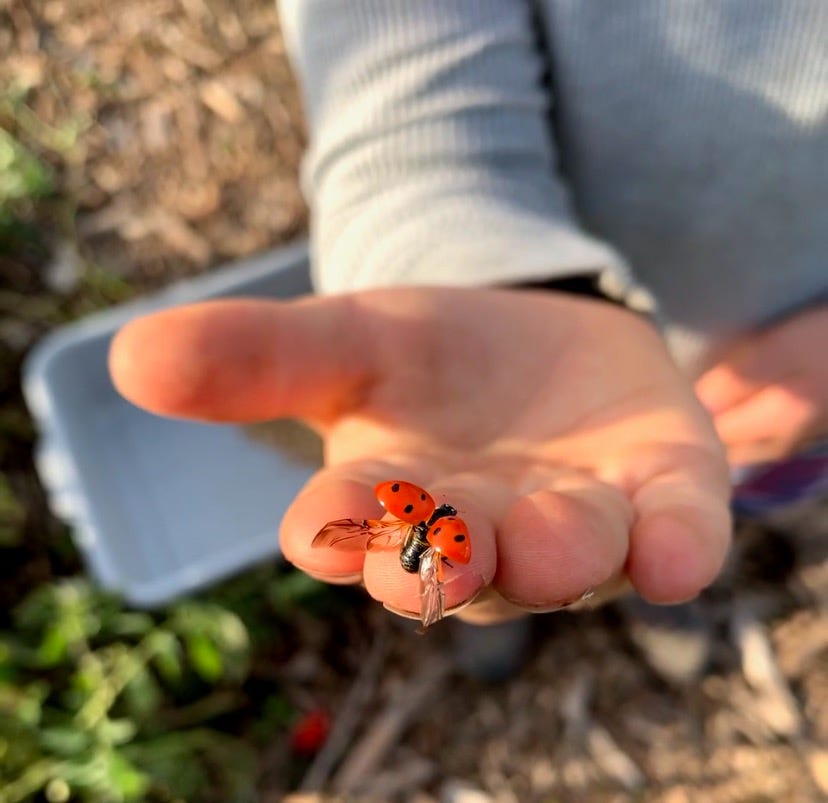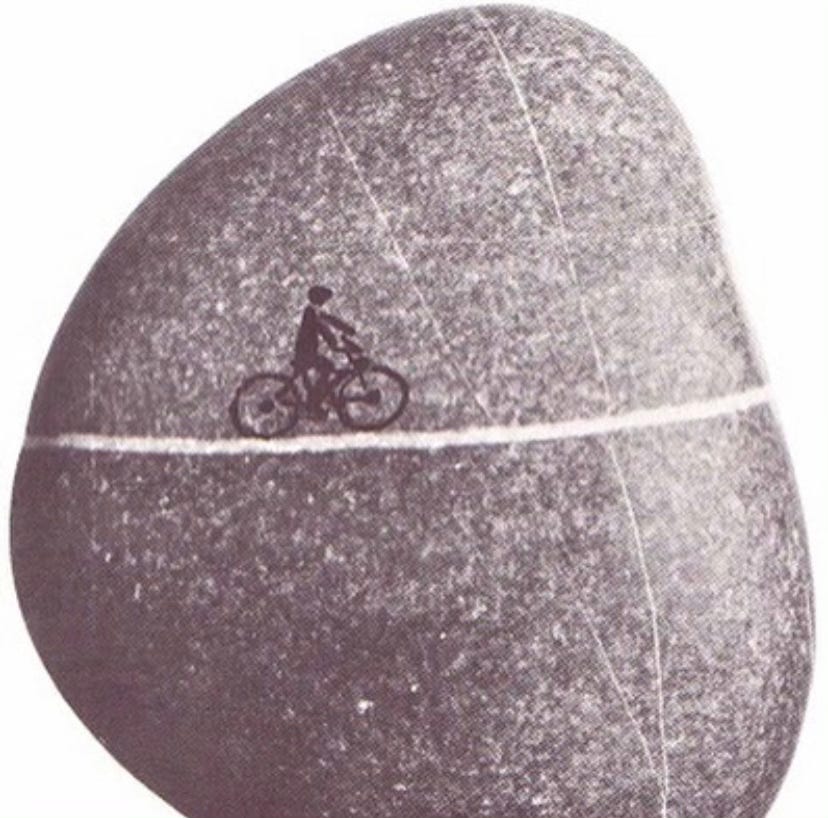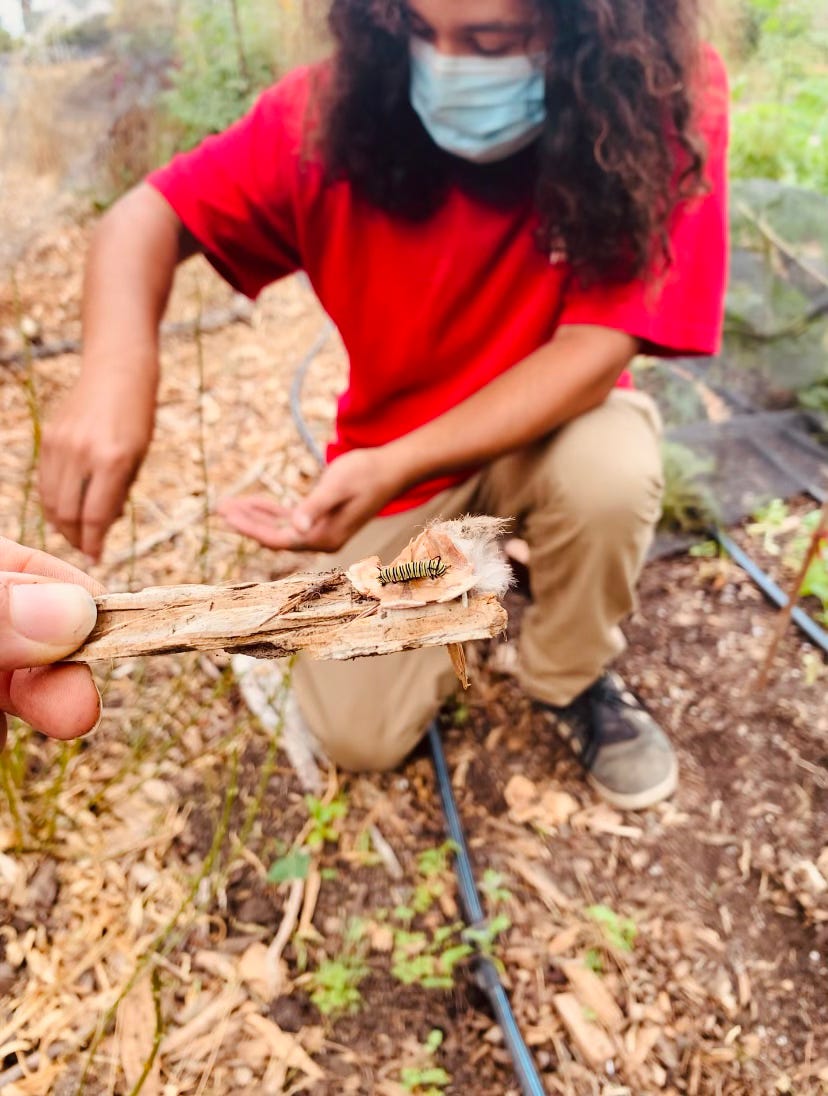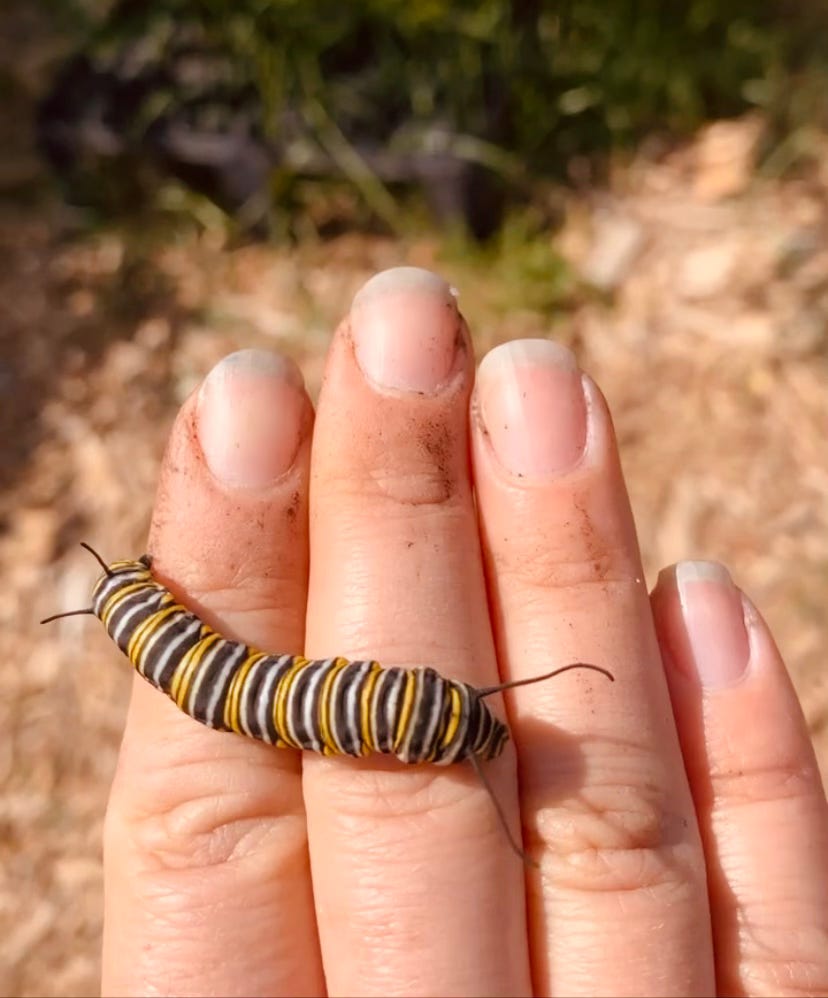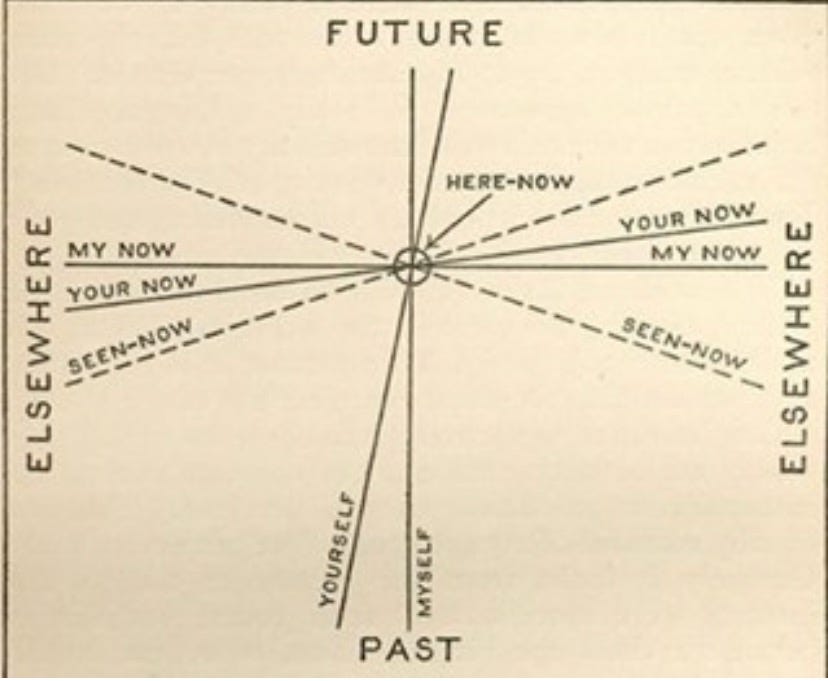Learning low and slow
I watch a lady bug tiptoe on the soft pad of a six-year old's forefinger. His name is Plum. Ladybugs are good luck according to Plum, and because he stated it one day with the impenetrable confidence and certainty that is childhood, it simply is a fact in my life now, too. The complimentary fact is: even though there are thousands of ladybugs on the farm, every time one catches your eye on a nearby plant or especially if one lands on you (!!!) you must stop everything. So, when this ladybug decided to grace Plum's finger one auspicious summer afternoon, we both froze and surrendered ourselves to this fleeting blessing. In a flash, the ladybug's retractable armor split its speckled back in two. Compacted wings folded beneath the hard shell burst open flawlessly for flight, launching off Plum's fleshy little platform and disappearing into the vastness again.
Plum's day is made. Touched by an angel.
The decisive determination of a child's reality, combined with the vivid imaginary they often inhabit in their minimally-conditioned, rapidly sense-making, sponge-like minds is such a refreshing change of frequency.
Children have an uncanny ability to remind you what you love and have forgotten about in the milieu of adulthood with taxes and bills and health insurance. And when you're in a place with an abundance of ladybugs and children simultaneously, your own inner child perks up and reminds you of it, too.
So does the constant invitation of the Earth.
This is how I spent a majority of my time in 2021. With kids, with my inner kid, surrounded by bugs and plants and birds. Low and close to the Earth. When I wasn't at the farm, I was in my garden or on a trail just watching the world be. I met my blue jay neighbors who loved to eat the dead bees scattered under the hive in peak honey-making season. I grieved the brief life of those hardworking bees but also imagined how that must be a sublime, nectar-filled delicacy for the jays, and I found peace in their sweet bird belly burials. I rescued a hummingbird from the brink of death and kept the local watering hole full for the neighborhood pollinators. All of this simply and profoundly possible because I could be here and not contained inside walls or on wheels elsewhere.
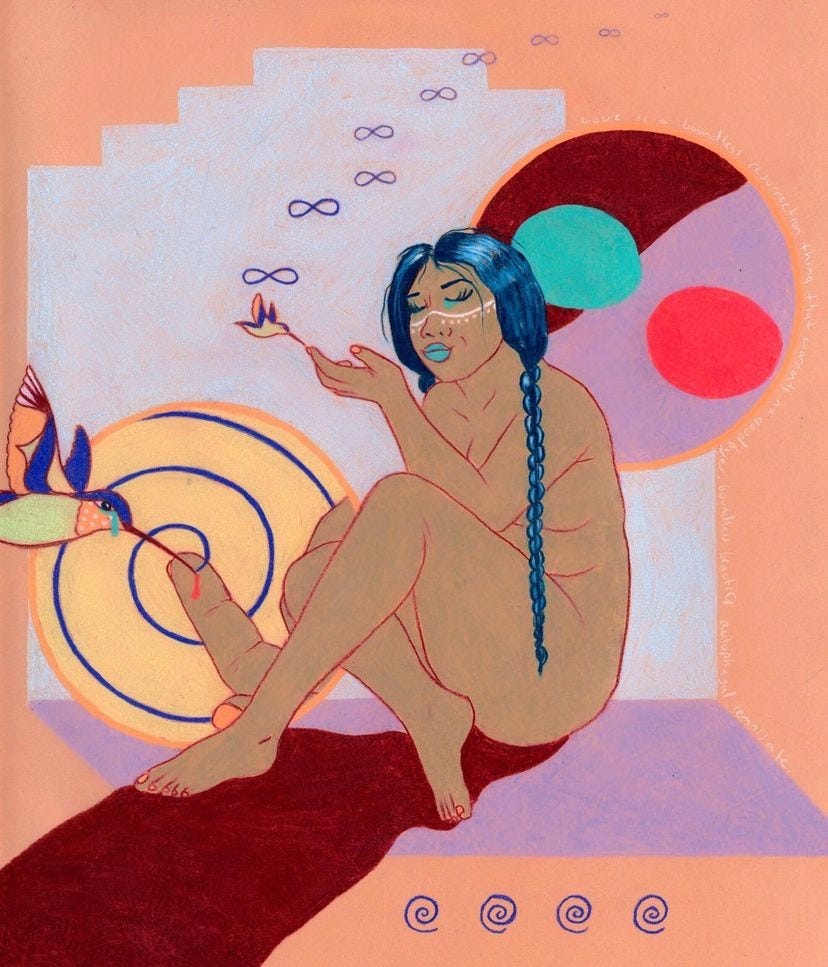
I feel lucky. I learned a lot. I want to write so much about it all, but today I just have a scattering of things that are flooding my heart, so I must begin to let it out imperfectly. Note: this is not a list of capital-T Truths. I'm not a child that can speak to you of True things! I'm almost 33 and riddled with doubt now! (But I'm glad of that fact, because doubt (as mentioned last time) is precious, and to grow up is a gift (sometimes a privilege).) I'm savoring aging and realizing that as I learn more I know less about everything. All that said, these are reflections:
Softness is power, receptivity is sacred.
Hardened and dense, cracked and brittle – amongst the cascading crises on our planet today, soil deterioration and erosion loom heavy as loamy soils have sacrificed so much of themselves to the relentlessness of anthropocentric abuse and exploitation. Fortunately, we're waking up. Stories of soil regeneration are growing like seed sprouts after fresh rainfall as we repair past transgressions (this 30-minute documentary is stunningly produced, incredibly informative, and worth a watch). Even the Sahara was once green, transformed into desert by overgrazing pastoralists who misused fire as a land management tool (sound familiar?). In China, the Loess plateau - an area the size of France - was desertified through heavy erosion and destruction over hundreds of years. Through permaculture practices, the region was brought back into a thriving, fertile ecosystem in 20 years (2 min PBS video here, and dive deeper here into a notion that includes nuanced controversy when seen as an avenue for more profiteering, not right relationship.)
On the farm I turn the compost piles and spray them with water to oxygenate and hydrate an alchemy of food scraps and wood chips and microbes into black Earth, rich with thriving, squirming, wriggling life eager to produce more life. I feel my hard edges soften, my blood vessels dilate, my heart ease. I relax and receive. Open is an essential precondition, a requisite remediation, for love and life to come in and take root.
How is your soul/soil seeking hydration, softness, receptivity? What might bring both literal and figurative moisture to your ecosystem?
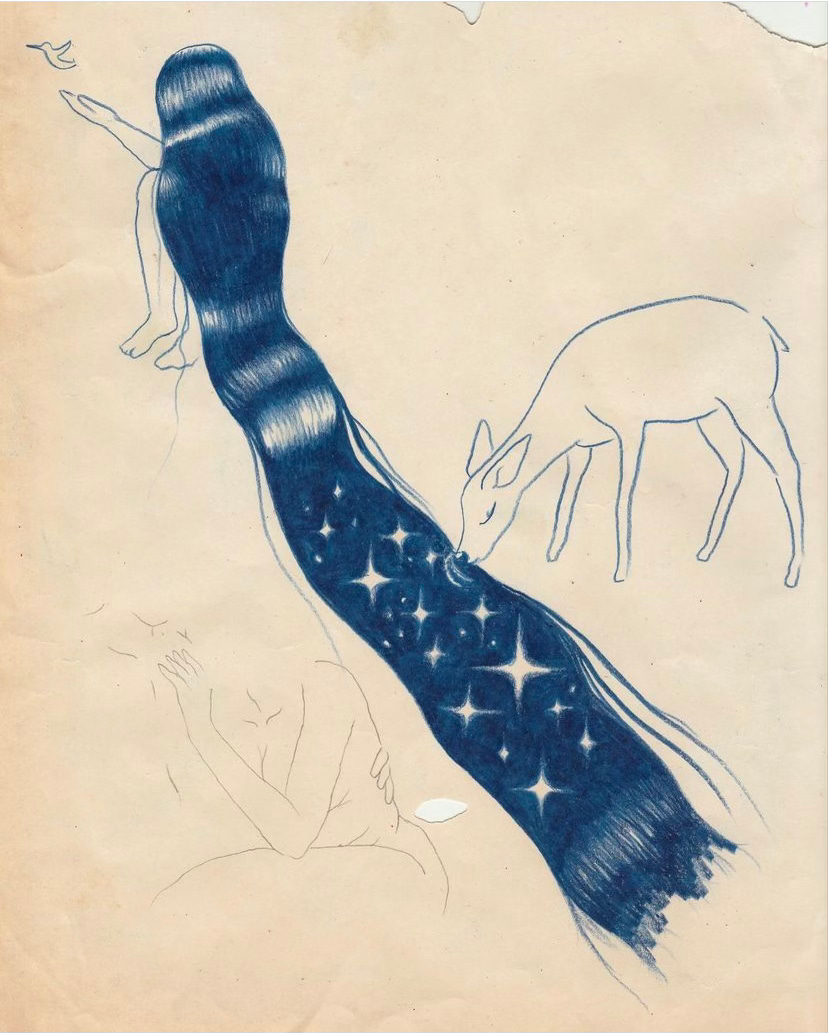
This is not a metaphor.
We and the Earth are one and the same: as within, so without. I wrote a poem last summer, as I struggled with the way abuse and trauma rendered itself in the dehydrated soils of my being, while feverishly tracking the eruptive fires all around me. It starts like this:
Parched lips attempt prayer, my body forgets itself as water.
How will the tears flow if the well is dry?
How will I cry if the reservoir is drained of all memories of moisture?
When does a drought shift from occasional to perennial,
from temporary to perpetual?
When exactly do we admit lasting change?
Acknowledge what will never be the same?
When do we call this new ecological stage a desertification age?
It arrives within me, threaded throughout my history.
Six generations of desert, my body can't seem to quench its thirst...
To remember myself as water. This is my prayer now. To be porous and permeable. To soften as nourishment seeps into my being. To be a potent force of change. To trust in the direction of my flow. To know my multiplicities. To change course and carve rocks in my path. My beloved friend Makshya (whose poetry will take your breath away, like here and here) and I spent expansive time on this theme this week. Our bodies are 60% water, and more specifically, the brain and heart 73%, the lungs 83%, muscles and kidneys 79%. The water in our cells is the water that pours from the sky and soaks crops into life. When Zen Master Thich Nhat Hanh was asked what we need to do to save our world, he replied, “to hear within us the sound of the earth crying.” Call it rain drop, call it tear drop. The oceans within and around us are swimming in plastic. The Earth mirrors back to us, at scale, what we are. As mentioned before, our hardware and our bodies share many of the same minerals and metals. The language around this is co-evolving in so many gorgeous places. I contributed a little to that here. How are we dissolving the metaphors that sometimes separate us, sometimes shield us, sometimes mask us? We are water. We are dust. The Earth is crying within us, as Thich Nhat Hanh reminds us.
Being with.
“With” feels like one of the most important words these days. With, not on. With, not above or outside. Compassion's etymology is “to suffer with.” How do we acknowledge that we are meant to be with Earth, to see the ways we suffer together. Perhaps this enormous grief we’re all carrying can only be held with something as massive as the Earth, perhaps the grief itself is so gigantic because it is centuries of Earth pain, perhaps it’s both. Breathing together. Grieving together. Makshya shared Taylor Johnson’s gorgeous essay Amongness with me this week. Johnson opens with an inchworm that mistakes his hair for a branch:
“That the inch worm would enter into my ecosystem, would break the idea of “my” such that I’m given to the circumstance wherein the inch worm, its bright green body almost unbelievable, falling maybe on its way to becoming a moth, would choose to be among my thinking as I’m walking, becomes involved in my thinking as I’m walking, my thinking becoming bright green almost unbelievable now. I’m thinking about being among and giving myself away in that amongness.”
Amongness, being with, re-members us into the family of beings. Isn’t it so exhausting to try to be separate, to constantly defend a false superiority over everything instead of sinking back into the holding that is amongness?
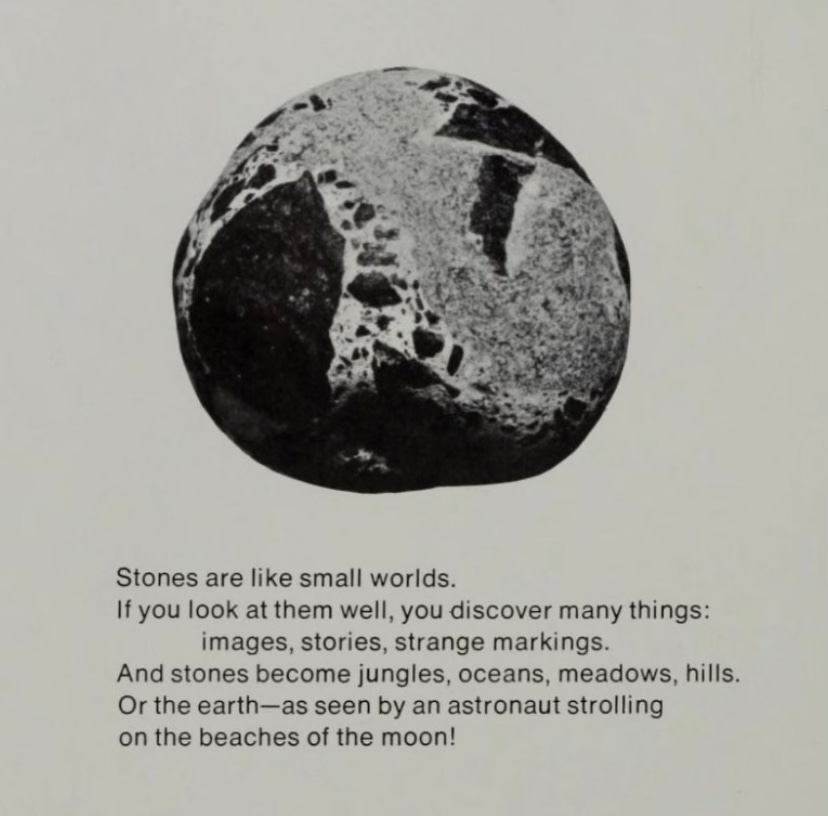
Places of no time show us how to pay attention.
A cosmic conversation with a beloved, a day in the field that calls your full attention to the immediacy all around you. In spaces of no time, the most subtle details have space to be seen. Nonverbal communications, transmissions from the otherwise and otherwheres, flood the senses. Notice: how the creatures around us move through space so particularly and what their location tell us about ours; what is specifically said and deliberately not said in this conversation, what wants to be heard between the words. I wasn't always attuned to this level of attention. I was fervently committed to linear time. Always scarce on a fleeting resource. A chronic multitasker. Fragmented in a million places, torn between past, present, and future, caught in numerous dialogues simultaneously (email, text, phone call, what I posted on instagram 3 hours ago, what my boss said 2 days ago, the presentation I need to give next week...). The pandemic stopped time for all of us in a very significant way, and even if it didn't last long, and even as it tries to snap back, everything has already changed. We're different now. “Normal” is immensely less tolerable as its fragility is made increasingly visible – was never going to hold up under consolidated scrutiny. And because everything stopped, we also remember how to pay attention: the light’s movement through our apartment windows, the sound of birdsong, the patterns of postal workers, the places we can breathe (and the places we can’t).
If the rush requires us to ignore, then the slow stretching of time invites us into awareness. The pandemic has blurred days into weeks into months, but look at how much more we can see now? I find myself on geologic time, on Earth time. I watch as the lemon beside me lingers in a deep green for what feels like eternity, until, suddenly, a blush of soft yellow emerges then spreads slowly, so slowly, into sunshine ready to eat. Moving slow and low one day also helped rescue hundreds of monarch caterpillars that had somehow found themselves on one far off milkweed plant they had voraciously chewed to stems. Without another food source nearby, all of them would have starved. It was only because we noticed some caterpillars lost in the lettuce rows, striving toward life, that we started to wonder. We picked them up one by one, tracing a trail of caterpillar “bread crumbs” to the sugar supply. We collected caterpillars as tiny as grains of rice and carried them over to the milkweed oasis across the farm.
When you pay attention, you see there are many beings that need it. What do you notice now that you didn't before? Further, once you consciously commune with no-time, you can conjure that feeling and shift more of your life from time-bound to timeless. What are the places/spaces that immerse you in no-time? Painting? Hiking? Sailing? Submerging your hands into clay and water to form vessels? Warming your feet by a crackling fire in the dead of winter? Entangling your limbs with a lover?
Magic happens in the darkness.
The divinity held in the notion that life itself starts in the dark means faith, trust, and surrender are design features of incarnation. An essential part of the process is to persist through the heavy cloak of all we cannot see and hold on to the thread of future potential. A baby, a butterfly, a seed, a chick, knows only the darkness, until its safe container becomes threateningly claustrophobic. It is painful to destroy or evacuate your only home, your only protection, but it is more dangerous to stay, in fact it is fatal. In the womb, in the egg, in the soil, mostly imperceptible, an entire life is growing. Then suddenly in one thrashing, writhing, emergent, miraculous moment, it arrives. Imagine if we were to dig up the buried seed mid-process? We would destroy it. A fixation on control, on prediction, on perfection is all a mythology disconnected from nature. Mystery and magic are interwoven with the intimacy of the evolutionary impulse toward life. Unfathomable treasures are held in the depths of Earth’s land masses and oceans: pearls, precious gemstones, mycelial webs, fungi, root systems... even decaying dinosaurs who may simply want to rest in peace, to saturate the soil with their ancient oils and serve some purpose much vaster than our speed and greed. What is this human drive to displace and dispossess? Perhaps we need to trust that these wonders are where they need to be, that they serve a purpose in their placement, and that to excavate, uproot, and extract them is to destabilize divine design.
I love the much-discussed notion of imaginal cells, such as those that govern the metamorphosis from caterpillar to butterfly. First, it takes the dissolution of the caterpillar into goo for the imaginal cells that hold the promise of the butterfly to activate. But these cells are so different that the caterpillar’s gooey, disembodied immune system mounts a defense against its future self’s butterfly becoming, a threat to its dying, impossible self! WHAT! The rapidly multiplying imaginal butterfly cells eventually overtake the caterpillar’s immune attack and claim the territory inside the chrysalis. Then, these individuated entities start vibrating at the same frequency, communicating the same language. They start to connect, cluster, collaborate, and become the entirely new winged organism that will soon burst forth. This process is mystifying, prophetic, and humbling. We have much to learn from this intelligence about transformation, about death and rebirth, about collective coherence to release the old paradigm and create the new – trusting that the information we need is already embedded into our genetic code, but it may take a psychospiritual, maybe even physical, death to become unrecognizable to our former selves in order to thrive. Our “immune systems” may fight to the death to protect what was, not knowing that what's yet to be is evolutionary destiny. The caterpillar is essential to the butterfly, but the time comes for the consumptive creature to surrender to the pollinating butterfly that blooms flower into fruit and serves in exponential life-giving.
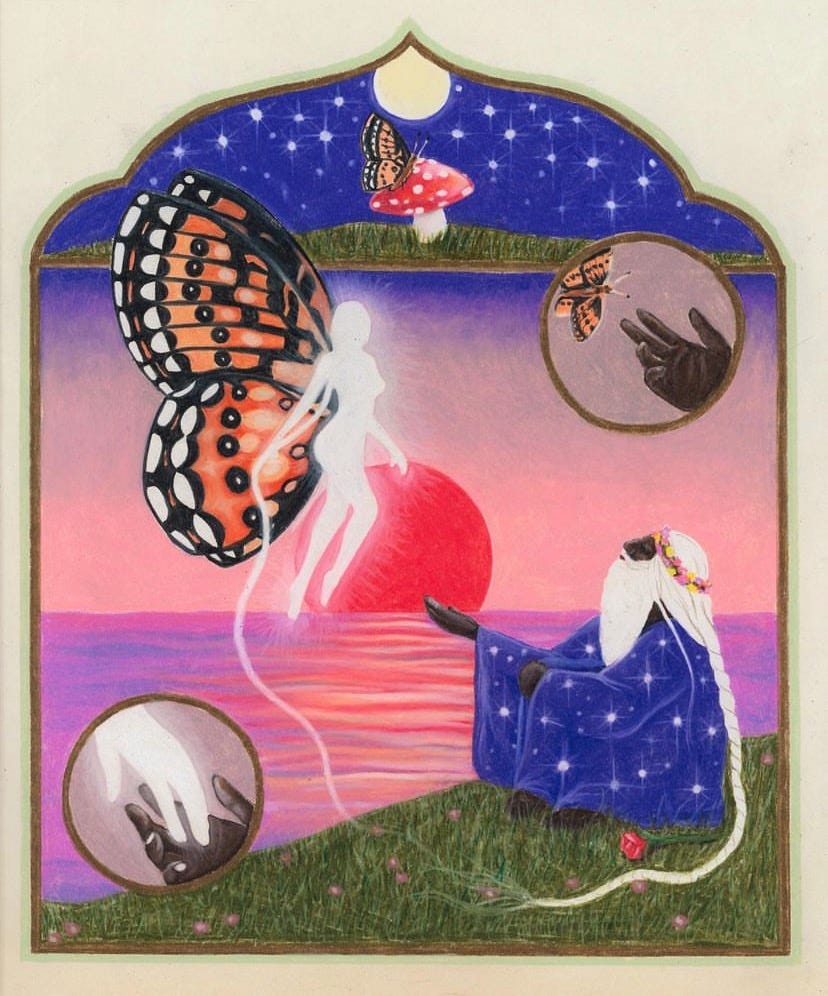
As I ponder this, I consider Nikki Giovanni's recent interview in the NYTimes Magazine. Speaking of Kyle Rittenhouse she said:
“I believe that it frightened him to think that he somehow might lose his life, and yet his life was no more important than anybody else’s. Couldn’t he realize that he was no different from any caterpillar walking on the sidewalk? If you can avoid stepping on it, then it will be a butterfly. But he chose to step on the caterpillar. He chose to stop whatever beauty would be.”
All I can say is: this is not a metaphor.
I have more scribbled notes to type into legibility soon, but I'll stop here with part 1. I know so many, if not all, of y'all are deeply in tune with Earth language, Earth impulse. I'd love to hear what reflections live in you about these themes, or anything you want to say below in the comments.
With love, til next time,
Rachel
If you value what you find here and would like to support my work, consider clicking that “heart” icon (swoon), leave a comment, share this with a loved one, and if you’re not a subscriber yet, join us! Gratitude to all who have become members! THANK YOU AND LOVE YOU!


